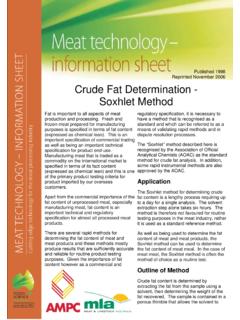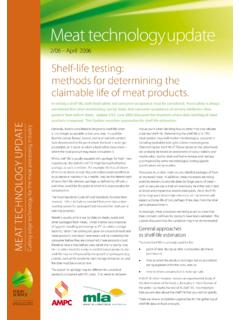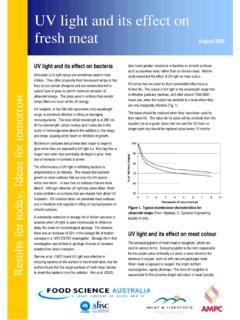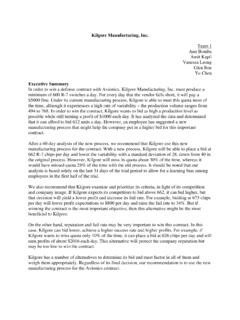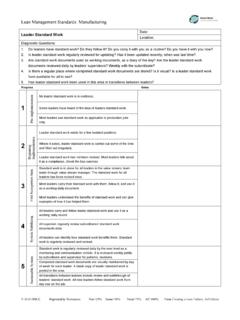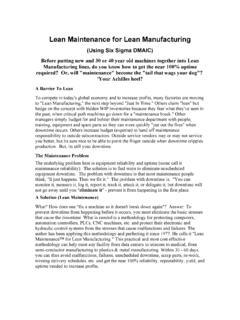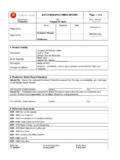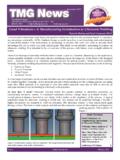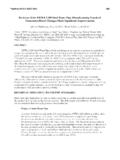Transcription of Meat Technology Update
1 Meat yield means different things to different sectors of the meat industry. Researchers often talk about the yield of dissectible muscle (usually referred to as percentage lean meat). On the other hand suppliers of carcase meat to the domestic and export markets are most interested in the yield of saleable meat from each carcase. Exporters of bulk-packed meat for manufacturing specify the percentage of chemical lean. Due to the variety of interpretations, there continues to be confusion about what is yield . Lean meat percent (LM) or chemical lean percent (CL) are easily standardised in terms of fat content, and can therefore be estimated accurately, making them widely used by the research fraternity.
2 Often the meat industry needs a definition that is more commercially recognisable such as saleable meat yield (SMY). SMY is more difficult to specify or predict than LM or CL because there are numerous market specifications, particularly in relation to the degree of fat trimming required. Definition of yield For the purpose of this article the following definitions are used: Lean meat percent (LM) Weight of muscle tissue that has been trimmed free of visible fat, expressed as a percentage of cold carcase weight. Chemical lean percent (CL) Lean meat content as determined by chemical analysis ( 100-chemical fat content).
3 Saleable meat yield percent (SMY) yield of bone-in or boneless cuts plus manufacturing meat that have been trimmed to a desired fat coverage or level and expressed as % of cold carcase weight. Carcase composition and yield Among carcases of similar weight, the proportions of the various carcase components ( muscle, fat and bone) vary considerably depending on breed type and growth rate. The proportion of muscle in the carcase is of major importance since this is the prime determinant of yield and commercial value. The ratio of fat to muscle is probably the single most important criterion by which consumers judge the quality and value for money.
4 There are three important factors when considering saleable meat yield : fat thickness; carcase weight; muscle-to-bone ratio. Fat thickness Fat is the most variable carcase component both in its amount and distribution. The three primary carcase components; muscle, bone and fat, each grow at different rates. Once the animal reaches its mature weight, muscle and bone growth taper off but the Understanding meat yield Newsletter 02/4 August 2002 Meat Technology Update deposition of fat continues. It is possible to indirectly estimate the proportion of muscle in a carcase by estimating its overall fatness.
5 The measurement of fat depth has, as a consequence, become an important component of carcase classification schemes for beef, sheep and pork carcases, worldwide. There are major fat depots within the carcase. The first to be deposited is the internal fat (kidney and channel fat), which represents about 4% of the carcase weight. The intermediate sites of deposition are beneath the skin (subcutaneous fat) and between the muscles (intermuscular fat). The remaining site of fat deposition is within the muscle (marbling). Marbling was thought to develop at a later age but this has recently been refuted.
6 Fat deposition occurs simultaneously within the depots but at different rates depending on the age of the animal. Carcase weight Carcase weight has a major influence, not only on the quantity of the various tissues, but also on the size of the individual muscles within the primal cuts. carcase weight is important, as the relationship between carcase weight and fatness varies between breeds and also between grass and grain-fed animals. Furthermore, the individual weights of various muscles and primal cuts are highly related to the total weight of the carcase so an understanding of this relationship is important when attempting to meet market specifications with regard to primal-cut weight.
7 Muscle-to-bone ratio After accounting for weight and fatness, the remaining variation in carcase composition in mixed breed populations is largely explained by differences in muscle: bone ratio. It is an important characteristic of any carcase in determining its ultimate value and, clearly, the higher the muscle:bone ratio, the better the yield . The muscle:bone ratio changes during growth and plateaus near its maximum value (around , and for bulls, steers and heifers, respectively) when animals reach about 50% of their mature weight. If animals are slaughtered beyond 50% maturity, there is little need to consider growth changes in this ratio.
8 However, if an animal is slaughtered earlier than this, when its overall weight and proportion of muscle are both increasing, the weight of saleable meat and, therefore, the value of the carcase, will increase appreciably after small time intervals ( weeks). While this has remained an important criterion when assessing yield , the accurate estimation of the muscle:bone ratio by means other than complete dissection of the carcase into component parts, has remained elusive. Subjective assessments of muscle score ( degree of muscling) have been used with varying degrees of success in live animal and carcase-classification systems as a proxy for muscle:bone ratio; however, such scores are still constrained by the vagaries of subjective assessment.
9 Production factors that influence yield Carcase composition can be controlled, within limits, by modifying the factors that influence the growth of different tissues. Muscle is the most desired tissue, bone is the least desired and fat is desired in different amounts by different markets and consumers. The production variables that control fatness are breed, live weight (and maturity) at slaughter, sex, and nutrition. Growth promotants are a recent short-term method for controlling fatness. They are used in approximately 90% of US lot-fed cattle and reasonably widely throughout Australia. The most important determinant producers will use when deciding how to manipulate carcase fatness will always be economic.
10 The returns for producing leaner stock must be financially worthwhile to both producers and processors for it to occur. Breed The genotype of the animal determines the potential for it to develop particular carcase characteristics and meat quality. Genetic differences in yield and fatness traits have been observed between breeds and between strains within breeds. No single cattle breed has all the attributes that are needed to produce beef efficiently in all environments, and to meet the requirements of all markets. The appropriate use of systematic crossbreeding programs provides significant benefits to the beef industry in terms of both yield and meat quality.
